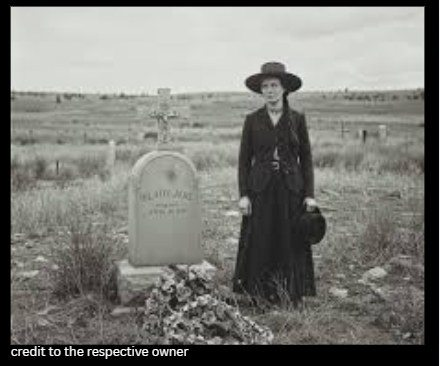There is a photograph, rare in its stillness, taken around 1903, that captures one of the most iconic scenes in the folklore of the American frontier: Calamity Jane—frontierswoman, scout, wanderer—standing at the gravesite of Wild Bill Hickok in Deadwood, South Dakota. It’s a moment suspended in time, a pause between myth and memory. Through weathered light and simple lines, the image reveals not just a figure, but a story.
A Grave Marked by Legend
Wild Bill Hickok’s life ended violently. In 1876, while playing poker in Deadwood, he was shot in the back. The hand he held at that moment — aces over eights — would forever be known as the “Dead Man’s Hand.” To much of the public, his death cemented him in the pantheon of Old West legends: gunslinger, gambler, showman.
But death is only part of the story.
Calamity Jane: Myth, Reality, and What Might Have Been
Calamity Jane—Martha Jane Canary—became known for the rugged life she led: roughing it in frontier towns, tending to the sick, raising hell, drinking hard, living loudly. Her legend is full of overstatement and contradictions. She claimed to have known Wild Bill, claimed loyalty, perhaps even deeper feelings. Historians debate how close they truly were — and whether any romantic tale is more construction than truth. Yet regardless of factual detail, her bond to his myth was unshakeable.

By 1903, both the Old West and its storytellers were fading. The railroads had stretched, law was (somewhat) more structured, pulsating camps were being replaced by small, quieter towns. Calamity Jane was aging, her toughness tempered by years, illness, regret, perhaps longing. In this photograph, the softness in her posture, the heaviness in her gaze — all of it speaks of memory. Not just of the man she admired…but of a world she saw slipping away.
The Moment Captured
Imagine approaching the burial ground in Deadwood in that chilly year. Perhaps morning light, damp earth. Calamity Jane, standing before the grave, wearing what she wore in life or something rugged but clean. She looks at the tombstone — no ceremony, no fanfare, but a quiet act of enduring loyalty. A woman once known for her loudness, for her defiance, stepping into silence.
She died later in 1903. In her final wish, she asked to be laid to rest next to Wild Bill Hickok. Whether out of love, out of loyalty, out of simple identification with his legend — or all those things — her request speaks of how intertwined their stories had become. More than flesh and blood, more than rumor, what remains is myth made manifest: two names, linked forever in American frontier lore.
Myth vs. Memory: What We Carry On
There are those who insist that her claims about Wild Bill were exaggerations. That she invented parts of her past to live up to a persona. Perhaps. Yet even if truth is murky, the emotional truth of that photograph is clear: Calamity Jane believed in something beyond mere facts. She believed in loyalty that outlasts death.
To look at her in that moment is to see someone aware of her own legend — someone carrying both pride and burden. It is to see the end of one chapter in the saga of the American frontier. The pioneering days, the lawlessness, the rawness — all giving way to a history that would be told, embellished, sanitized.
Why the Image Still Haunts
Because it asks more questions than it answers. What was she thinking in that moment? How much of her life had she reconciled with — her regrets, her losses? How much of Wild Bill’s death haunted her? We’ll never know fully. The photograph holds what remains: grief, affection, myth, and loyalty.
And maybe that’s enough. For in the end, legends survive not because every detail is true, but because they touch something real in us — courage, desire, love, loss. Jane and Bill: two people irrevocably bound in public imagination. In this image, Jane stands as both a mourner and a storyteller, reminding us that some stories are only as powerful as those who remain to tell them.